성평등(Gender Equality) 관련 인식 - WIN 다국가 조사
- 조사일 : 2021/12/18
- [GallupReport(20220308)_Gender_WIN.pdf] 다운로드
● 2022년 3월 8일(화) 공개 | 문의: 02-3702-2571/2621/2622
성평등(Gender Equality) 관련 인식 - WIN 다국가 조사
→ 한국+세계 조사 결과 파일 다운로드(PDF)
/ 세계 조사 개요
2021년 10~12월 39개국 성인 총 33,236명 전화/온라인/면접조사(주제별 참여국 상이)
/ 한국 조사 개요
- 조사기간: 2021년 11월 5~28일
- 표본추출: 층화 집락 확률 비례 추출
- 응답방식: 면접조사원 인터뷰
- 조사대상: 전국(제주 제외) 만 19세 이상 1,500명
- 표본오차: ±2.5%포인트(95% 신뢰수준)
- 응답률: 28%(총 접촉 5,394명 중 1,500명 응답 완료)
- 의뢰처: 한국갤럽-WIN 자체 조사
/ 조사 항목
- 영역별 성평등 성취 여부: 일터·직장 / 정치 / 가정
- 일자리·경력 기회의 성별 차이
- 지난 1년간 정신적·신체적 등 어떤 형태의 폭력으로 고통받은 적이 있는가?
- 지난 1년간 성희롱 당한 경험이 있는가?
(※ 세계 조사 상세 결과는 첨부 파일 참조)
요약
- 39개국 성인 영역별 성평등 성취 동의율: 가정 70%, 직장 60%, 정치 50%
- 대체로 남성이 여성보다 더 성평등한 사회에 산다고 느껴
- 3개 영역 종합 최상위국 핀란드, 일본은 매년 최하위권
- 한국 정치에서의 성평등 성취 1년 전보다 후퇴, 직장에서는 개선
- 한국인, 다른 나라보다 남녀 간 시각차 큰 편
- 39개국 성인, '남성보다 여성의 일자리·경력 기회가 더 적다' 45%
조사 결과
2021년 10~12월 39개국 성인, 영역별 성평등 성취 동의율:
가정 70%, 직장 60%, 정치 50%
- 대체로 남성이 여성보다 더 성평등한 사회에 산다고 느껴
- 한국인, 다른 나라보다 남녀 간 시각차 큰 편
글로벌 조사 네트워크 WIN이 2021년 10~12월 39개국 성인 33,236명에게 성평등이 얼마나 이뤄졌는지에 대한 주관적 인식을 일터·직장, 정치, 가정 등 3개 영역별로 물었다(4점 척도). 그 결과 39개국 성인 중 70%가 자국의 가정에서 '성평등이 (확실히+어느 정도) 이뤄졌다'고 답했다. 일터·직장(이하 '직장')에서 '성평등이 이뤄졌다'(이하 '성취')는 응답은 60%, 정치 영역에서는 50%로 나타났다.
◎ 영역별 성평등 성취 응답을 종합하면 핀란드(직장 78%, 정치 86%, 가정 84%)가 39개국 중 최상위다. 반면, 일본(직장 30%, 정치 19%, 가정 45%)은 예년과 마찬가지로 최하위권에 머물렀다.
◎ 이 조사는 39개국 성인이 자국에서 성평등이 얼마나 이루어졌다고 느끼는지에 대한 인식만을 알아보고 있다. 유엔개발계획(UNDP)의 성불평등지수(GII)나 세계경제포럼(WEF)의 성별격차지수(GGI) 등은 주로 국가 통계, 법적·경제적 제도와 권리 등 여러 측면을 포괄하여 산출된다는 차이가 있다. 즉, 개인이 느끼는 자국의 성평등 정도가 반드시 그 나라의 객관적 성평등 수준을 의미하는 것은 아님에 주의해야 한다.
◎ 국가별, 응답자 특성별 성평등 성취 여부 인식 비교를 좀 더 쉽게 하기 위해 순(純)지수(Net Score: 성취-미성취 응답 차이, 수치가 클수록 더 성평등하다고 느낌) 기준으로 보면 39개국 전체 평균은 가정 45, 직장 26, 정치 7 순이며, 모두 1년 전과 대동소이하다.
◎ 3개 영역 성평등 성취 순지수를 성별로 보면 정치에서 남성(13)과 여성(0) 차이가 13, 직장(남성 35, 여성 18)에서는 17, 가정(51, 40)에서 11이다. 즉, 전반적으로 남성이 여성보다 더 성평등한 사회에 산다고 느낀다. 이는 지난 4년간 조사에서 일관된 경향이다.
◎ 한국 조사는 2021년 11월 5~28일 전국(제주 제외) 성인 1,500명을 대상으로 했다. 그 결과 한국인의 영역별 성평등 성취 응답은 가정에서 76%, 직장에서 72%, 정치에서 45%로 나타났다. 직장과 가정에서는 조사 참여국 평균을 웃돌지만, 정치에서는 그렇지 못하다. 1년 전과 비교하면 직장에서의 성평등 성취 인식은 나아졌고(순지수 26 → 46), 정치에서는 후퇴했다(0 → -6). 또한 우리나라는 다른 나라보다 남녀 간 시각차가 큰 편이라는 데 주목할 만하다.
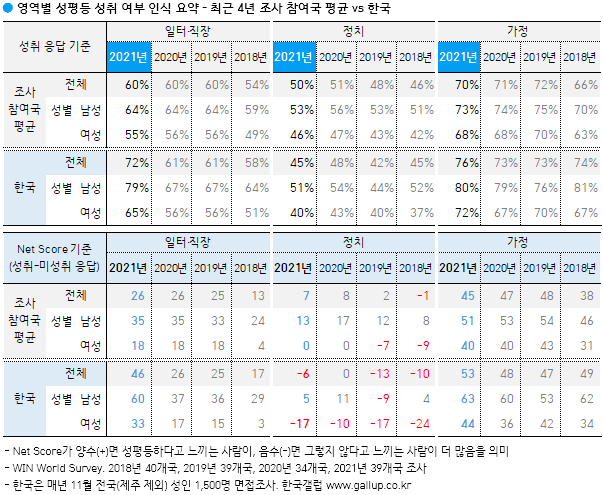
__
국가별 & 한국 교차 집계표
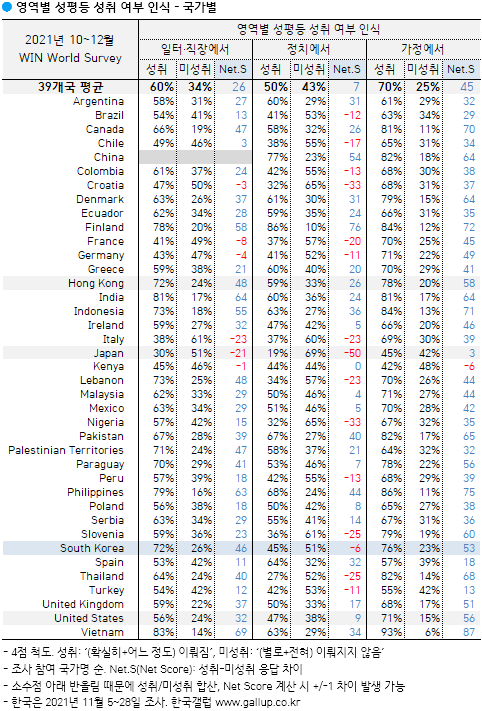
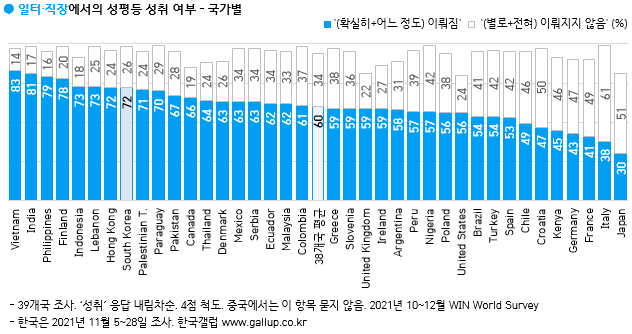
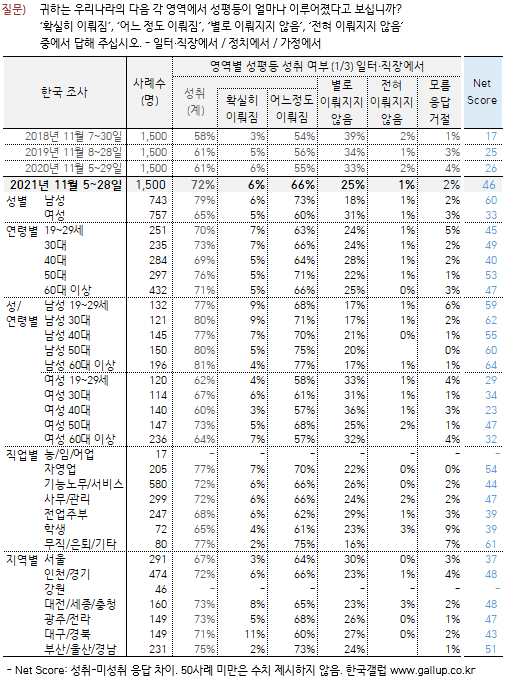
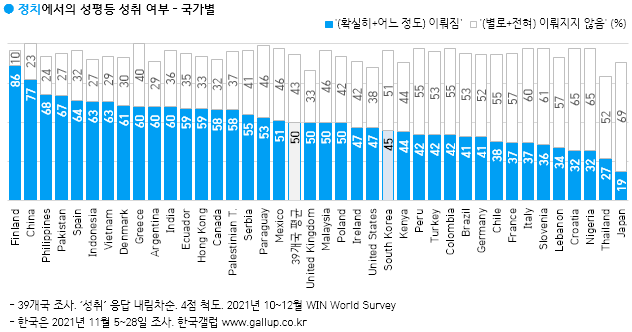
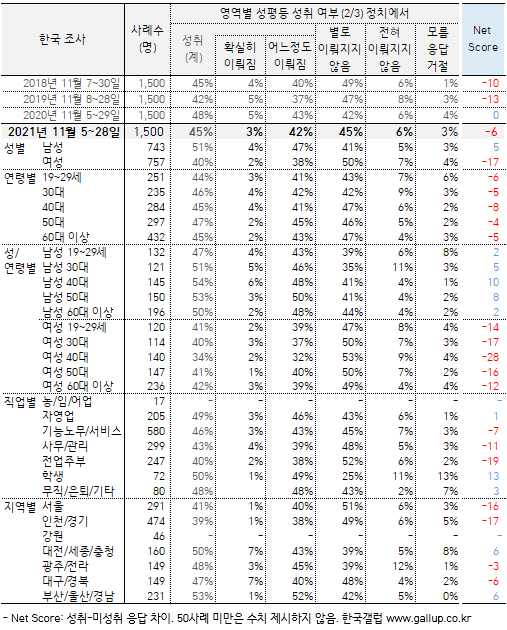
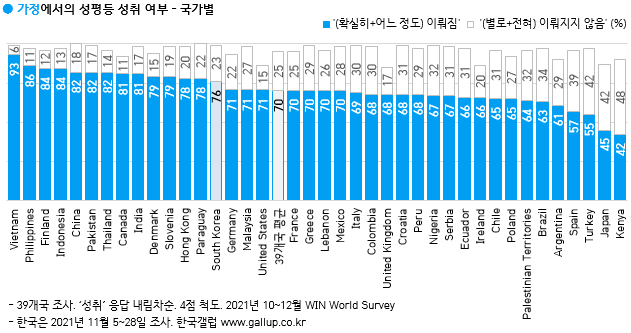
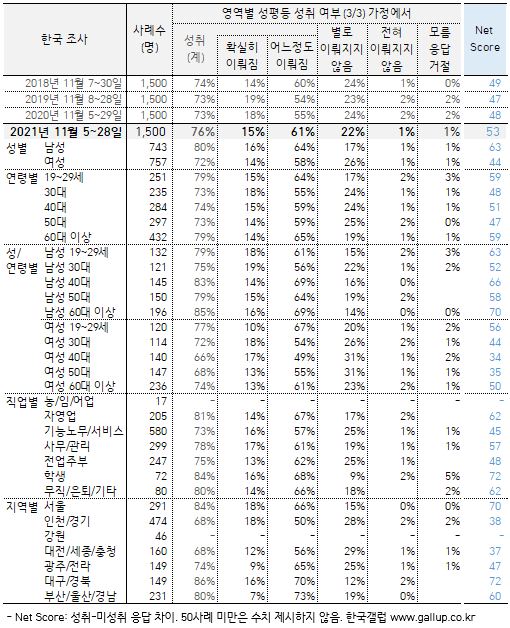
__
39개국 성인, '여성의 일자리·경력 기회, 남성보다 적다' 45%
'남녀 차이 없다' 37%, '남성보다 많다' 14%
- '여성의 기회가 적다': 남성 37%, 여성 55%
다음으로, 39개국 성인에게 일자리와 경력 관리 측면에서 볼 때 자국에서는 남성 대비 여성의 기회가 많은지 적은지 물었다. 그 결과 '여성의 기회가 더 적다'가 45%, '여성의 기회가 더 많다'는 응답은 14%였다. 37%는 '남녀 차이 없다'고 답했고, 4%는 의견을 유보했다.
◎ 성별로 보면 남성의 37%가 '여성의 일자리·경력 기회가 더 적다'고 보며, 여성에서는 그 비율이 55%로 한층 높았다. '남녀 차이 없다'는 응답은 남성(42%)에서 여성(32%)을 앞섰고, '여성의 기회가 더 많다'고 느끼는 사람은 남성 17%, 여성 10%였다.
◎ '여성의 일자리·경력 기회가 더 적다'는 응답은 브라질·크로아티아(72%), 이탈리아(71%), 칠레(70%), 일본(67%), 프랑스(64%) 등에서 60%를 웃돌았고, '남녀 차이가 없다'는 응답은 중국(78%), 베트남(69%), 인도네시아(63%), 필리핀(59%), 홍콩(58%) 순으로 많았다.
◎ 한국인은 43%가 '남녀 차이 없다'고 답했고, '여성의 기회가 더 적다' 41%, '여성의 기회가 더 많다' 14%, 그리고 2%는 의견을 유보했다. 한국 남성의 절반(49%)은 일자리·경력 기회 측면에서 성별 차이가 없다고 봤으나, 여성의 절반(48%)은 여성의 기회가 적다고 느끼는 것으로 나타났다.
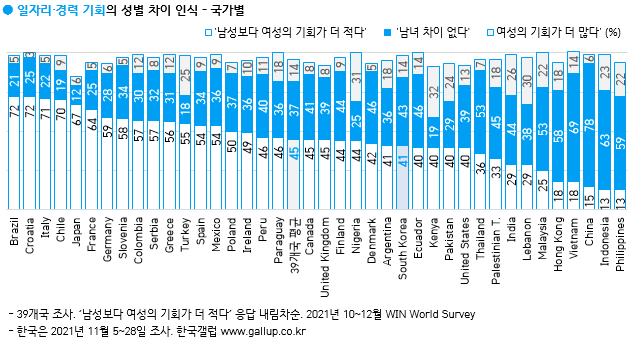
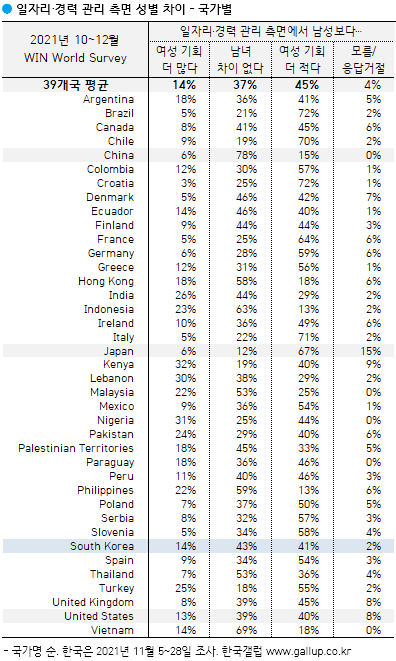
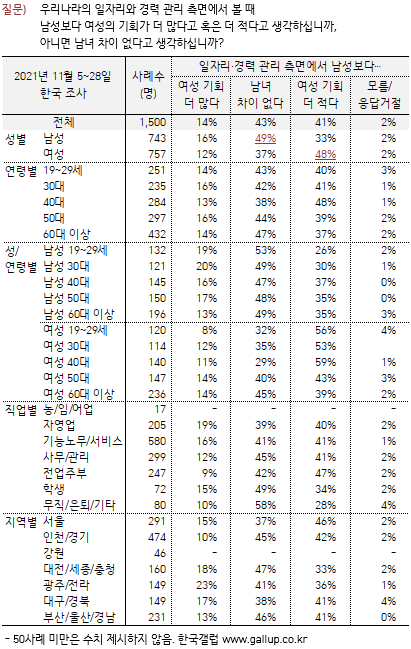
__
37개국 성인 중 14%, '지난 1년간 어떤 형태의 폭력으로 고통받은 적 있다'
- 주요국 경험률: 아르헨티나 34%... 일본·미국 10% 내외, 중국·한국 2%
37개국 성인에게 지난 1년간 정신적·신체적 등 어떤 형태의 폭력으로 고통받은 적 있는지 물은 결과 14%가 '있다'고 답했다. 폭력으로 고통받은 경험률은 남성 13%, 여성 16%며, 저연령일수록 그 비율이 높았다(18~24세 21%, 25~34세 18%; 55~64세 11%, 65세 이상 5%).
◎ 조사 참여국 중 지난 1년간 어떤 형태의 폭력으로 고통받은 경험률이 가장 높은 나라는 아르헨티나(34%), 인도(31%), 칠레(30%), 멕시코(26%) 순이다. 그 외 주요국 경험률은 홍콩 17%, 일본 11%, 독일·미국 10% 등이며 한국은 2%로, 중국(4%), 베트남(0.1%)과 함께 가장 낮은 편에 속했다.
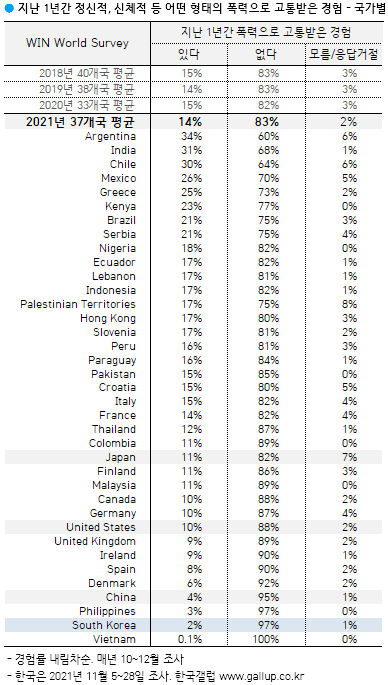
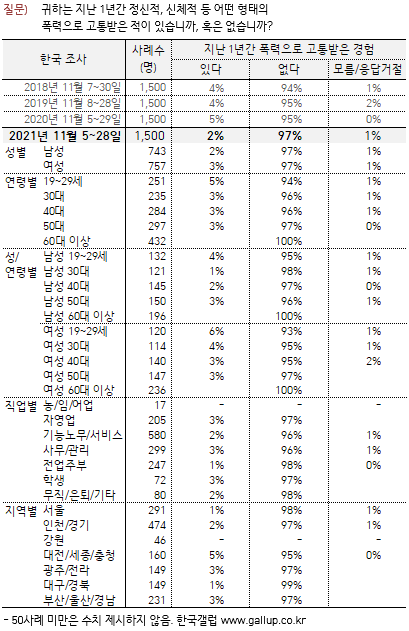
__
36개국 성인 중 7%, '지난 1년간 성희롱 당한 경험 있다' - 여성은 9%
- 주요국 경험률: 멕시코(17%)... 일본·미국 6%, 중국 2%, 한국 1%
- 폭력에 따른 고통 경험률 높은 나라가 대체로 성희롱 피해 경험률도 높아
36개국 성인 중 7%가 지난 1년간 성희롱을 당한 경험이 있다고 답했으며, 여성의 성희롱 피해 경험률은 9%였다. 조사 참여국 중 지난 1년간 성희롱 피해 경험률이 가장 높은 나라는 멕시코(17%), 인도·칠레(15%), 브라질(14%) 순이다. 한국은 1%로, 필리핀(1%), 베트남(0.5%) 등과 함께 낮은 편에 속했다. 폭력에 따른 고통 경험률이 높은 나라는 대체로 성희롱 피해 경험률도 높았다.
◎ 단, 이번 조사에서는 '성희롱(Sexual harassment)'이라는 단어에 부가적인 설명이나 예시 없이 질문하고 답을 받았음에 주의해야 한다. 친밀한 관계에서의 언어적·신체적 접촉이나 공공장소에서의 애정 표현 등에 대한 수용 정도는 문화적 배경이나 나라별 상황에 따라 크게 다를 수 있다.
예를 들어, 우리나라 여성가족부가 주관한 〈2018년 성희롱 실태조사〉(3년 주기 국가승인통계 제154018호)에서는 직장 내 성희롱 피해 경험률이 8.1%로 파악됐다. 그 수치는 '외모에 대한 성적 비유나 평가', '음담패설 및 성적 농담', '회식에서 술을 따르거나 옆에 앉도록 강요하는 행위' 등 구체적인 행위를 적시하고 이를 포괄하여 성희롱 피해 경험으로 집계한 결과다.
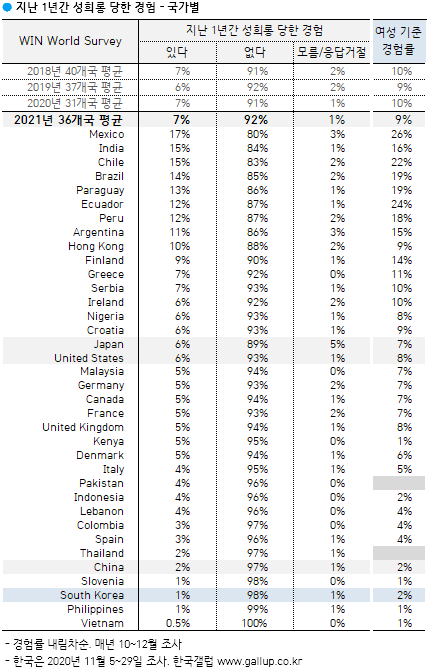
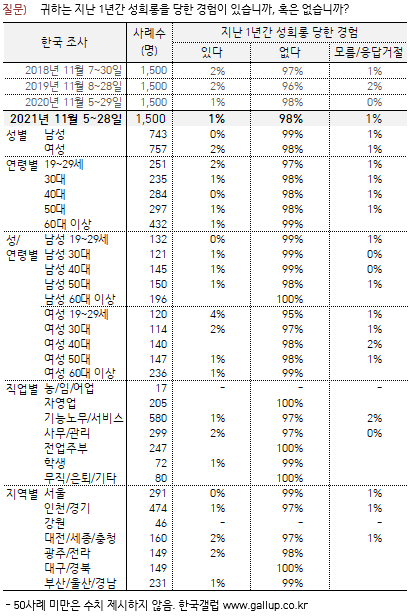
──────────────────────
Equal Opportunities and Rights: a Global Picture
──────────────────────
WIN International, the world's leading association in market research and polling has published the Annual WIN World Survey - WWS 2021 - exploring the views and beliefs of 33236 individuals among citizens from 39 countries across the globe. On International Women’s Day, WIN releases the latest results of the survey about gender equality, violence and sexual harassment, to understand what are, if any, the improvements around the world in terms of equal opportunities and rights.
Achievements in Gender Equality
When considering different environments where to measure the level of gender equality, home is still the place where equal rights are perceived the most, just like in previous years. In 2021, 70% of the global population believes gender equality has been achieved at home, however, there is also a slight but constant decrease when comparing the last three years (from 72% to 71% to 70%, TTB: Definitely achieved + somewhat achieved).
Globally, 60% of the population believes gender equality has been achieved in workplaces, but it is indeed the political sphere once again the most difficult environment for men and women to be considered equal: half of the population thinks gender equality has been achieved in politics, a share that slightly decreases compared to last year results (from 48% in 2019 to 51% in 2020 and 50% in 2021).
The countries where the highest net indexes in gender equity have been obtained are Vietman (69 points), Finland (75 points) and the Philippines (74 points), for work, politics and home, respectively. On the other hand, the lowest net indexes are obtained by Italy in work (-22 points), Japan in politics (-51) and Kenya at home (-22 points).
Job opportunities and career
Having established that 60% of the population believes gender equality has been achieved at work, the survey deep dives for the first time this year into some more specifical questions about equal job opportunities and careers. On a total level, 37% of the population believes that women have the same opportunities than men when it comes to jobs and career achievements, a share that is interestingly a bit lower among females themselves (32%). Most of the population, both on a total level and within females, believes women have less opportunities than men (total: 45%; among women: 55%). There is also a minor share of the respondents (14% of the total population, 10% among females) who believes women have more opportunities.
Europe and Americas seem to be the most critical regions in the world, as 55% and 52% of the respondents respectively believe women have less opportunities than men at jobs; women having the same opportunities is, on the other hand, an opinion widely shared in APAC, where 48% of the population believes it, +11% than global average.
Violence
At a global level, results about women experiencing physical or psychological violence are unfortunately stable compared to previous years: 16% in 2021, 17% in 2020, 16% in 2019. However, when analyzing data by regions, some small improvements can be found: in Africa, MENA, APAC and Americas the net index about women experiencing violence in the past year decreases by -7, -5, -2 and -1 respectively.
Young women aged 18 to 24 experience the highest incidence of physical and psychological violence (22%) although the share decreases by two points compared to last year. Likewise, women who have reached only full primary school are more likely to say they experienced violence (20%), and the same goes for female students among other occupational groups (20%).
Regarding the results by country, women in Ecuador report a sharp increase in the levels of violence (from 14% to 24%); the same happens in Mexico (from 32% to 36%) and Brazil from 24% to 28%. Greece also shows a high level of violence against women (32%).
Sexual harassment
The trend about women who experienced sexual harassment is also almost stable: 9% of women interviewed worldwide suffered sexual harassment in the last year, compared to 8% of the previous year. Young women from 18 to 24 years are the ones who have suffered the most from sexual harassment compared to other age groups, even one point more than the previous year (19% in 2021 and 18% in 2020). On a brightest note, Africa seems to have reduced the share of women who experienced sexual harassment, with a share that decreases by 4 percentage points (from 8% to 4%). However, in the Americas, victims of sexual harassment keep being 16% just like last year. The countries where women report the highest percentages of sexual harassment in 2021 are Mexico (26%), Ecuador (24%) and Chile (22%). While the Philippines (1%), China (1%) and Croatia (1%) are the countries with the lowest percentages. Ecuador has suffered a sharp increase in sexual harassment (from 15% to 24%) also Chile (from 18% to 22%) and Argentina (from 11% to 15%). India surprises with a reduction from 29% to 16% and Hong Kong from 13% to 9%.
Vilma Scarpino, President of WIN International Association, said:
“Reaching equal opportunities and rights for men and women, as well as reducing the level of violence experienced, is an effort that needs to be encouraged by many different actors within society, men and women together, and in different environments, as the WIN World Survey shows. Gender equality at home does not imply that the same equality has been achieved at work or in politics, not even in the same country. This points towards the need to involve as many actors as possible in promoting and encouraging equality. And it is not only about involving different actors, but it is also about acting on different levels too: gender equality is an international goal that needs to be faced also from a local and a national level, as shown by differences and slight improvements in some countries when it comes violence experienced.”
_____
응답자 특성표
조사 결과는 행정안전부 주민등록인구 기준으로 가중 처리하여 최종 결과를 산출합니다. 아래 응답자 특성표의 조사완료 사례수는 실제 응답 완료한 인원, 가중값 적용 사례수는 2021년 7월 행정안전부 주민등록인구 기준 성/연령/지역별 셀 가중 처리 후 인원입니다.
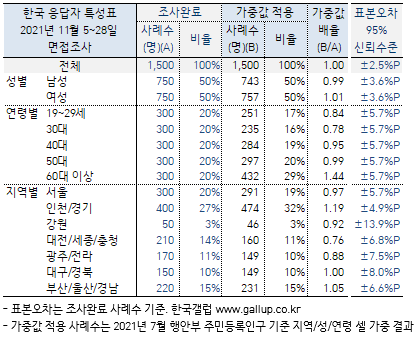
| 오늘(3월 8일)은 114주년 세계 여성의 날입니다. 이날은 1908년 3월 8일 미국의 여성 노동자들이 노동 환경 개선과 참정권 등을 요구하며 대규모 시위에 나선 데서 시작됐고, 1977년 유엔으로부터 '세계 여성의 날'로 공식 지정됐으며 우리나라에서는 2018년 법정기념일이 됐습니다. ● 전 대륙에서 시장조사와 여론조사를 하는 글로벌 네트워크 WIN(Worldwide Independent Network of Market Research)은 매년 말 건강, 환경, IT 등 여러 분야 현안에 관해 다국가 조사를 하고 있습니다. 지난 2월 공개한 〈기후변화와 지속가능성〉에 이어 〈성평등〉 관련 인식을 전합니다. 일부 항목은 2018년, 2019년, 2020년과도 비교 가능합니다. |
성평등(Gender Equality) 관련 인식 - WIN 다국가 조사
→ 한국+세계 조사 결과 파일 다운로드(PDF)
/ 세계 조사 개요
2021년 10~12월 39개국 성인 총 33,236명 전화/온라인/면접조사(주제별 참여국 상이)
/ 한국 조사 개요
- 조사기간: 2021년 11월 5~28일
- 표본추출: 층화 집락 확률 비례 추출
- 응답방식: 면접조사원 인터뷰
- 조사대상: 전국(제주 제외) 만 19세 이상 1,500명
- 표본오차: ±2.5%포인트(95% 신뢰수준)
- 응답률: 28%(총 접촉 5,394명 중 1,500명 응답 완료)
- 의뢰처: 한국갤럽-WIN 자체 조사
/ 조사 항목
- 영역별 성평등 성취 여부: 일터·직장 / 정치 / 가정
- 일자리·경력 기회의 성별 차이
- 지난 1년간 정신적·신체적 등 어떤 형태의 폭력으로 고통받은 적이 있는가?
- 지난 1년간 성희롱 당한 경험이 있는가?
(※ 세계 조사 상세 결과는 첨부 파일 참조)
요약
- 39개국 성인 영역별 성평등 성취 동의율: 가정 70%, 직장 60%, 정치 50%
- 대체로 남성이 여성보다 더 성평등한 사회에 산다고 느껴
- 3개 영역 종합 최상위국 핀란드, 일본은 매년 최하위권
- 한국 정치에서의 성평등 성취 1년 전보다 후퇴, 직장에서는 개선
- 한국인, 다른 나라보다 남녀 간 시각차 큰 편
- 39개국 성인, '남성보다 여성의 일자리·경력 기회가 더 적다' 45%
조사 결과
2021년 10~12월 39개국 성인, 영역별 성평등 성취 동의율:
가정 70%, 직장 60%, 정치 50%
- 대체로 남성이 여성보다 더 성평등한 사회에 산다고 느껴
- 한국인, 다른 나라보다 남녀 간 시각차 큰 편
글로벌 조사 네트워크 WIN이 2021년 10~12월 39개국 성인 33,236명에게 성평등이 얼마나 이뤄졌는지에 대한 주관적 인식을 일터·직장, 정치, 가정 등 3개 영역별로 물었다(4점 척도). 그 결과 39개국 성인 중 70%가 자국의 가정에서 '성평등이 (확실히+어느 정도) 이뤄졌다'고 답했다. 일터·직장(이하 '직장')에서 '성평등이 이뤄졌다'(이하 '성취')는 응답은 60%, 정치 영역에서는 50%로 나타났다.
◎ 영역별 성평등 성취 응답을 종합하면 핀란드(직장 78%, 정치 86%, 가정 84%)가 39개국 중 최상위다. 반면, 일본(직장 30%, 정치 19%, 가정 45%)은 예년과 마찬가지로 최하위권에 머물렀다.
◎ 이 조사는 39개국 성인이 자국에서 성평등이 얼마나 이루어졌다고 느끼는지에 대한 인식만을 알아보고 있다. 유엔개발계획(UNDP)의 성불평등지수(GII)나 세계경제포럼(WEF)의 성별격차지수(GGI) 등은 주로 국가 통계, 법적·경제적 제도와 권리 등 여러 측면을 포괄하여 산출된다는 차이가 있다. 즉, 개인이 느끼는 자국의 성평등 정도가 반드시 그 나라의 객관적 성평등 수준을 의미하는 것은 아님에 주의해야 한다.
◎ 국가별, 응답자 특성별 성평등 성취 여부 인식 비교를 좀 더 쉽게 하기 위해 순(純)지수(Net Score: 성취-미성취 응답 차이, 수치가 클수록 더 성평등하다고 느낌) 기준으로 보면 39개국 전체 평균은 가정 45, 직장 26, 정치 7 순이며, 모두 1년 전과 대동소이하다.
◎ 3개 영역 성평등 성취 순지수를 성별로 보면 정치에서 남성(13)과 여성(0) 차이가 13, 직장(남성 35, 여성 18)에서는 17, 가정(51, 40)에서 11이다. 즉, 전반적으로 남성이 여성보다 더 성평등한 사회에 산다고 느낀다. 이는 지난 4년간 조사에서 일관된 경향이다.
◎ 한국 조사는 2021년 11월 5~28일 전국(제주 제외) 성인 1,500명을 대상으로 했다. 그 결과 한국인의 영역별 성평등 성취 응답은 가정에서 76%, 직장에서 72%, 정치에서 45%로 나타났다. 직장과 가정에서는 조사 참여국 평균을 웃돌지만, 정치에서는 그렇지 못하다. 1년 전과 비교하면 직장에서의 성평등 성취 인식은 나아졌고(순지수 26 → 46), 정치에서는 후퇴했다(0 → -6). 또한 우리나라는 다른 나라보다 남녀 간 시각차가 큰 편이라는 데 주목할 만하다.

__
국가별 & 한국 교차 집계표







__
39개국 성인, '여성의 일자리·경력 기회, 남성보다 적다' 45%
'남녀 차이 없다' 37%, '남성보다 많다' 14%
- '여성의 기회가 적다': 남성 37%, 여성 55%
다음으로, 39개국 성인에게 일자리와 경력 관리 측면에서 볼 때 자국에서는 남성 대비 여성의 기회가 많은지 적은지 물었다. 그 결과 '여성의 기회가 더 적다'가 45%, '여성의 기회가 더 많다'는 응답은 14%였다. 37%는 '남녀 차이 없다'고 답했고, 4%는 의견을 유보했다.
◎ 성별로 보면 남성의 37%가 '여성의 일자리·경력 기회가 더 적다'고 보며, 여성에서는 그 비율이 55%로 한층 높았다. '남녀 차이 없다'는 응답은 남성(42%)에서 여성(32%)을 앞섰고, '여성의 기회가 더 많다'고 느끼는 사람은 남성 17%, 여성 10%였다.
◎ '여성의 일자리·경력 기회가 더 적다'는 응답은 브라질·크로아티아(72%), 이탈리아(71%), 칠레(70%), 일본(67%), 프랑스(64%) 등에서 60%를 웃돌았고, '남녀 차이가 없다'는 응답은 중국(78%), 베트남(69%), 인도네시아(63%), 필리핀(59%), 홍콩(58%) 순으로 많았다.
◎ 한국인은 43%가 '남녀 차이 없다'고 답했고, '여성의 기회가 더 적다' 41%, '여성의 기회가 더 많다' 14%, 그리고 2%는 의견을 유보했다. 한국 남성의 절반(49%)은 일자리·경력 기회 측면에서 성별 차이가 없다고 봤으나, 여성의 절반(48%)은 여성의 기회가 적다고 느끼는 것으로 나타났다.



__
37개국 성인 중 14%, '지난 1년간 어떤 형태의 폭력으로 고통받은 적 있다'
- 주요국 경험률: 아르헨티나 34%... 일본·미국 10% 내외, 중국·한국 2%
37개국 성인에게 지난 1년간 정신적·신체적 등 어떤 형태의 폭력으로 고통받은 적 있는지 물은 결과 14%가 '있다'고 답했다. 폭력으로 고통받은 경험률은 남성 13%, 여성 16%며, 저연령일수록 그 비율이 높았다(18~24세 21%, 25~34세 18%; 55~64세 11%, 65세 이상 5%).
◎ 조사 참여국 중 지난 1년간 어떤 형태의 폭력으로 고통받은 경험률이 가장 높은 나라는 아르헨티나(34%), 인도(31%), 칠레(30%), 멕시코(26%) 순이다. 그 외 주요국 경험률은 홍콩 17%, 일본 11%, 독일·미국 10% 등이며 한국은 2%로, 중국(4%), 베트남(0.1%)과 함께 가장 낮은 편에 속했다.


__
36개국 성인 중 7%, '지난 1년간 성희롱 당한 경험 있다' - 여성은 9%
- 주요국 경험률: 멕시코(17%)... 일본·미국 6%, 중국 2%, 한국 1%
- 폭력에 따른 고통 경험률 높은 나라가 대체로 성희롱 피해 경험률도 높아
36개국 성인 중 7%가 지난 1년간 성희롱을 당한 경험이 있다고 답했으며, 여성의 성희롱 피해 경험률은 9%였다. 조사 참여국 중 지난 1년간 성희롱 피해 경험률이 가장 높은 나라는 멕시코(17%), 인도·칠레(15%), 브라질(14%) 순이다. 한국은 1%로, 필리핀(1%), 베트남(0.5%) 등과 함께 낮은 편에 속했다. 폭력에 따른 고통 경험률이 높은 나라는 대체로 성희롱 피해 경험률도 높았다.
◎ 단, 이번 조사에서는 '성희롱(Sexual harassment)'이라는 단어에 부가적인 설명이나 예시 없이 질문하고 답을 받았음에 주의해야 한다. 친밀한 관계에서의 언어적·신체적 접촉이나 공공장소에서의 애정 표현 등에 대한 수용 정도는 문화적 배경이나 나라별 상황에 따라 크게 다를 수 있다.
예를 들어, 우리나라 여성가족부가 주관한 〈2018년 성희롱 실태조사〉(3년 주기 국가승인통계 제154018호)에서는 직장 내 성희롱 피해 경험률이 8.1%로 파악됐다. 그 수치는 '외모에 대한 성적 비유나 평가', '음담패설 및 성적 농담', '회식에서 술을 따르거나 옆에 앉도록 강요하는 행위' 등 구체적인 행위를 적시하고 이를 포괄하여 성희롱 피해 경험으로 집계한 결과다.


──────────────────────
Equal Opportunities and Rights: a Global Picture
──────────────────────
WIN International, the world's leading association in market research and polling has published the Annual WIN World Survey - WWS 2021 - exploring the views and beliefs of 33236 individuals among citizens from 39 countries across the globe. On International Women’s Day, WIN releases the latest results of the survey about gender equality, violence and sexual harassment, to understand what are, if any, the improvements around the world in terms of equal opportunities and rights.
Achievements in Gender Equality
When considering different environments where to measure the level of gender equality, home is still the place where equal rights are perceived the most, just like in previous years. In 2021, 70% of the global population believes gender equality has been achieved at home, however, there is also a slight but constant decrease when comparing the last three years (from 72% to 71% to 70%, TTB: Definitely achieved + somewhat achieved).
Globally, 60% of the population believes gender equality has been achieved in workplaces, but it is indeed the political sphere once again the most difficult environment for men and women to be considered equal: half of the population thinks gender equality has been achieved in politics, a share that slightly decreases compared to last year results (from 48% in 2019 to 51% in 2020 and 50% in 2021).
The countries where the highest net indexes in gender equity have been obtained are Vietman (69 points), Finland (75 points) and the Philippines (74 points), for work, politics and home, respectively. On the other hand, the lowest net indexes are obtained by Italy in work (-22 points), Japan in politics (-51) and Kenya at home (-22 points).
Job opportunities and career
Having established that 60% of the population believes gender equality has been achieved at work, the survey deep dives for the first time this year into some more specifical questions about equal job opportunities and careers. On a total level, 37% of the population believes that women have the same opportunities than men when it comes to jobs and career achievements, a share that is interestingly a bit lower among females themselves (32%). Most of the population, both on a total level and within females, believes women have less opportunities than men (total: 45%; among women: 55%). There is also a minor share of the respondents (14% of the total population, 10% among females) who believes women have more opportunities.
Europe and Americas seem to be the most critical regions in the world, as 55% and 52% of the respondents respectively believe women have less opportunities than men at jobs; women having the same opportunities is, on the other hand, an opinion widely shared in APAC, where 48% of the population believes it, +11% than global average.
Violence
At a global level, results about women experiencing physical or psychological violence are unfortunately stable compared to previous years: 16% in 2021, 17% in 2020, 16% in 2019. However, when analyzing data by regions, some small improvements can be found: in Africa, MENA, APAC and Americas the net index about women experiencing violence in the past year decreases by -7, -5, -2 and -1 respectively.
Young women aged 18 to 24 experience the highest incidence of physical and psychological violence (22%) although the share decreases by two points compared to last year. Likewise, women who have reached only full primary school are more likely to say they experienced violence (20%), and the same goes for female students among other occupational groups (20%).
Regarding the results by country, women in Ecuador report a sharp increase in the levels of violence (from 14% to 24%); the same happens in Mexico (from 32% to 36%) and Brazil from 24% to 28%. Greece also shows a high level of violence against women (32%).
Sexual harassment
The trend about women who experienced sexual harassment is also almost stable: 9% of women interviewed worldwide suffered sexual harassment in the last year, compared to 8% of the previous year. Young women from 18 to 24 years are the ones who have suffered the most from sexual harassment compared to other age groups, even one point more than the previous year (19% in 2021 and 18% in 2020). On a brightest note, Africa seems to have reduced the share of women who experienced sexual harassment, with a share that decreases by 4 percentage points (from 8% to 4%). However, in the Americas, victims of sexual harassment keep being 16% just like last year. The countries where women report the highest percentages of sexual harassment in 2021 are Mexico (26%), Ecuador (24%) and Chile (22%). While the Philippines (1%), China (1%) and Croatia (1%) are the countries with the lowest percentages. Ecuador has suffered a sharp increase in sexual harassment (from 15% to 24%) also Chile (from 18% to 22%) and Argentina (from 11% to 15%). India surprises with a reduction from 29% to 16% and Hong Kong from 13% to 9%.
Vilma Scarpino, President of WIN International Association, said:
“Reaching equal opportunities and rights for men and women, as well as reducing the level of violence experienced, is an effort that needs to be encouraged by many different actors within society, men and women together, and in different environments, as the WIN World Survey shows. Gender equality at home does not imply that the same equality has been achieved at work or in politics, not even in the same country. This points towards the need to involve as many actors as possible in promoting and encouraging equality. And it is not only about involving different actors, but it is also about acting on different levels too: gender equality is an international goal that needs to be faced also from a local and a national level, as shown by differences and slight improvements in some countries when it comes violence experienced.”
_____
응답자 특성표
조사 결과는 행정안전부 주민등록인구 기준으로 가중 처리하여 최종 결과를 산출합니다. 아래 응답자 특성표의 조사완료 사례수는 실제 응답 완료한 인원, 가중값 적용 사례수는 2021년 7월 행정안전부 주민등록인구 기준 성/연령/지역별 셀 가중 처리 후 인원입니다.
